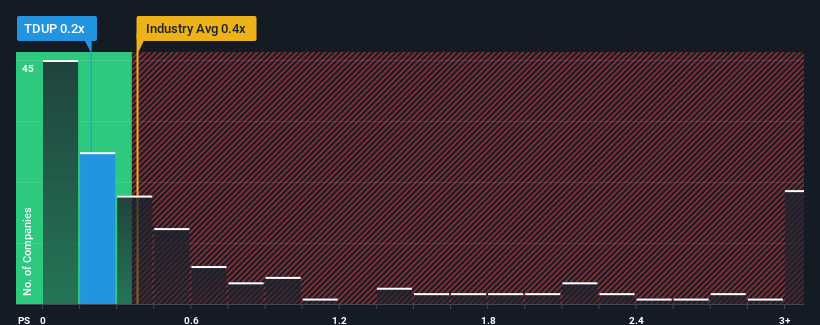Stock Analysis
- United States
- /
- Specialty Stores
- /
- NasdaqGS:TDUP
Risks Still Elevated At These Prices As ThredUp Inc. (NASDAQ:TDUP) Shares Dive 30%

Unfortunately for some shareholders, the ThredUp Inc. (NASDAQ:TDUP) share price has dived 30% in the last thirty days, prolonging recent pain. For any long-term shareholders, the last month ends a year to forget by locking in a 85% share price decline.
Although its price has dipped substantially, you could still be forgiven for feeling indifferent about ThredUp's P/S ratio of 0.2x, since the median price-to-sales (or "P/S") ratio for the Specialty Retail industry in the United States is also close to 0.4x. Although, it's not wise to simply ignore the P/S without explanation as investors may be disregarding a distinct opportunity or a costly mistake.
View our latest analysis for ThredUp

How Has ThredUp Performed Recently?
Recent times have been advantageous for ThredUp as its revenues have been rising faster than most other companies. It might be that many expect the strong revenue performance to wane, which has kept the P/S ratio from rising. If you like the company, you'd be hoping this isn't the case so that you could potentially pick up some stock while it's not quite in favour.
Want the full picture on analyst estimates for the company? Then our free report on ThredUp will help you uncover what's on the horizon.How Is ThredUp's Revenue Growth Trending?
The only time you'd be comfortable seeing a P/S like ThredUp's is when the company's growth is tracking the industry closely.
Taking a look back first, we see that the company managed to grow revenues by a handy 8.4% last year. This was backed up an excellent period prior to see revenue up by 57% in total over the last three years. So we can start by confirming that the company has done a great job of growing revenues over that time.
Looking ahead now, revenue is anticipated to slump, contracting by 6.0% during the coming year according to the four analysts following the company. Meanwhile, the broader industry is forecast to expand by 3.9%, which paints a poor picture.
In light of this, it's somewhat alarming that ThredUp's P/S sits in line with the majority of other companies. Apparently many investors in the company reject the analyst cohort's pessimism and aren't willing to let go of their stock right now. There's a good chance these shareholders are setting themselves up for future disappointment if the P/S falls to levels more in line with the negative growth outlook.
What Does ThredUp's P/S Mean For Investors?
ThredUp's plummeting stock price has brought its P/S back to a similar region as the rest of the industry. While the price-to-sales ratio shouldn't be the defining factor in whether you buy a stock or not, it's quite a capable barometer of revenue expectations.
It appears that ThredUp currently trades on a higher than expected P/S for a company whose revenues are forecast to decline. With this in mind, we don't feel the current P/S is justified as declining revenues are unlikely to support a more positive sentiment for long. If the declining revenues were to materialize in the form of a declining share price, shareholders will be feeling the pinch.
Don't forget that there may be other risks. For instance, we've identified 4 warning signs for ThredUp (1 is potentially serious) you should be aware of.
If companies with solid past earnings growth is up your alley, you may wish to see this free collection of other companies with strong earnings growth and low P/E ratios.
Valuation is complex, but we're here to simplify it.
Discover if ThredUp might be undervalued or overvalued with our detailed analysis, featuring fair value estimates, potential risks, dividends, insider trades, and its financial condition.
Access Free AnalysisHave feedback on this article? Concerned about the content? Get in touch with us directly. Alternatively, email editorial-team (at) simplywallst.com.
This article by Simply Wall St is general in nature. We provide commentary based on historical data and analyst forecasts only using an unbiased methodology and our articles are not intended to be financial advice. It does not constitute a recommendation to buy or sell any stock, and does not take account of your objectives, or your financial situation. We aim to bring you long-term focused analysis driven by fundamental data. Note that our analysis may not factor in the latest price-sensitive company announcements or qualitative material. Simply Wall St has no position in any stocks mentioned.
About NasdaqGS:TDUP
ThredUp
Operates an online resale platform in the United States and internationally.


